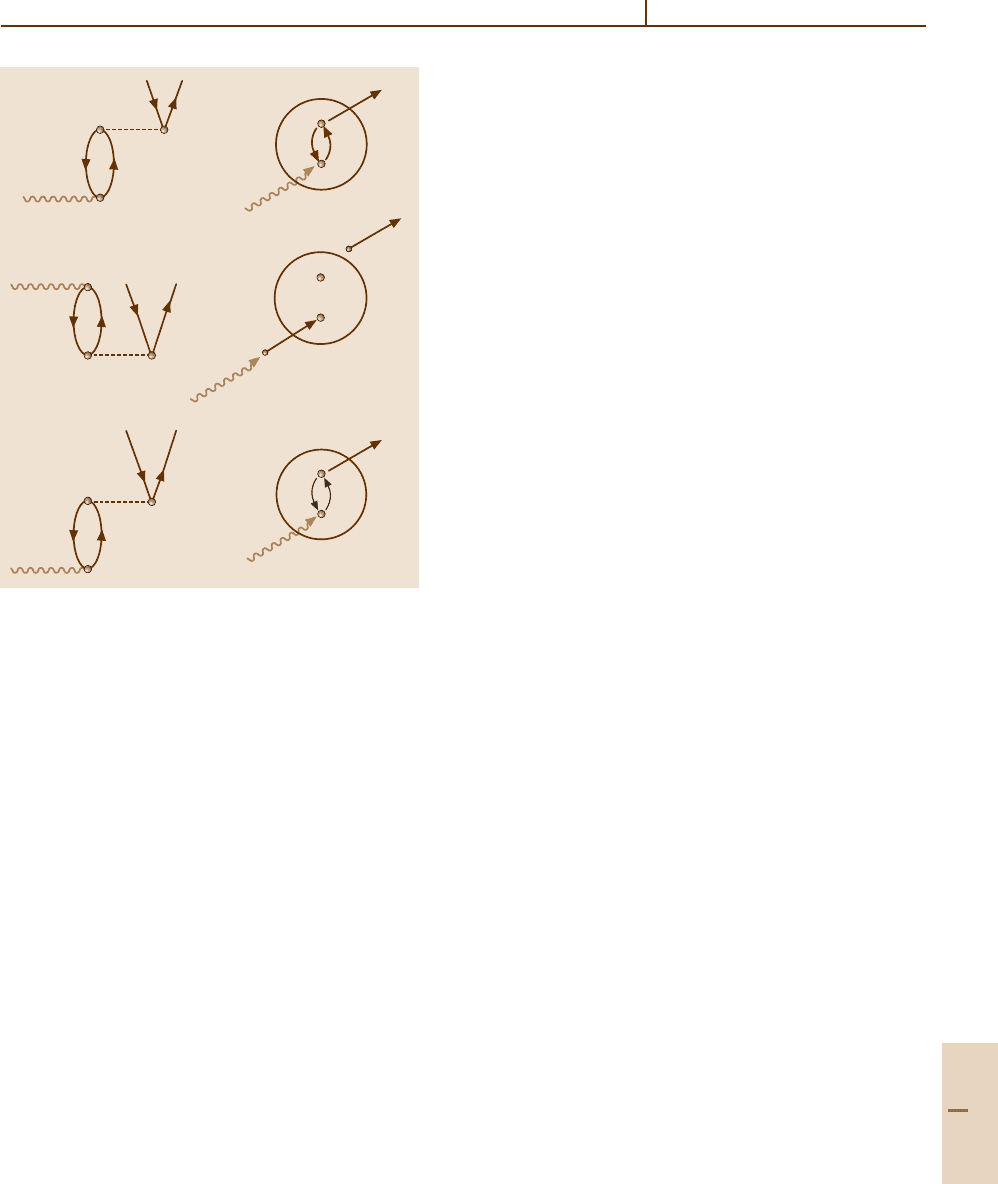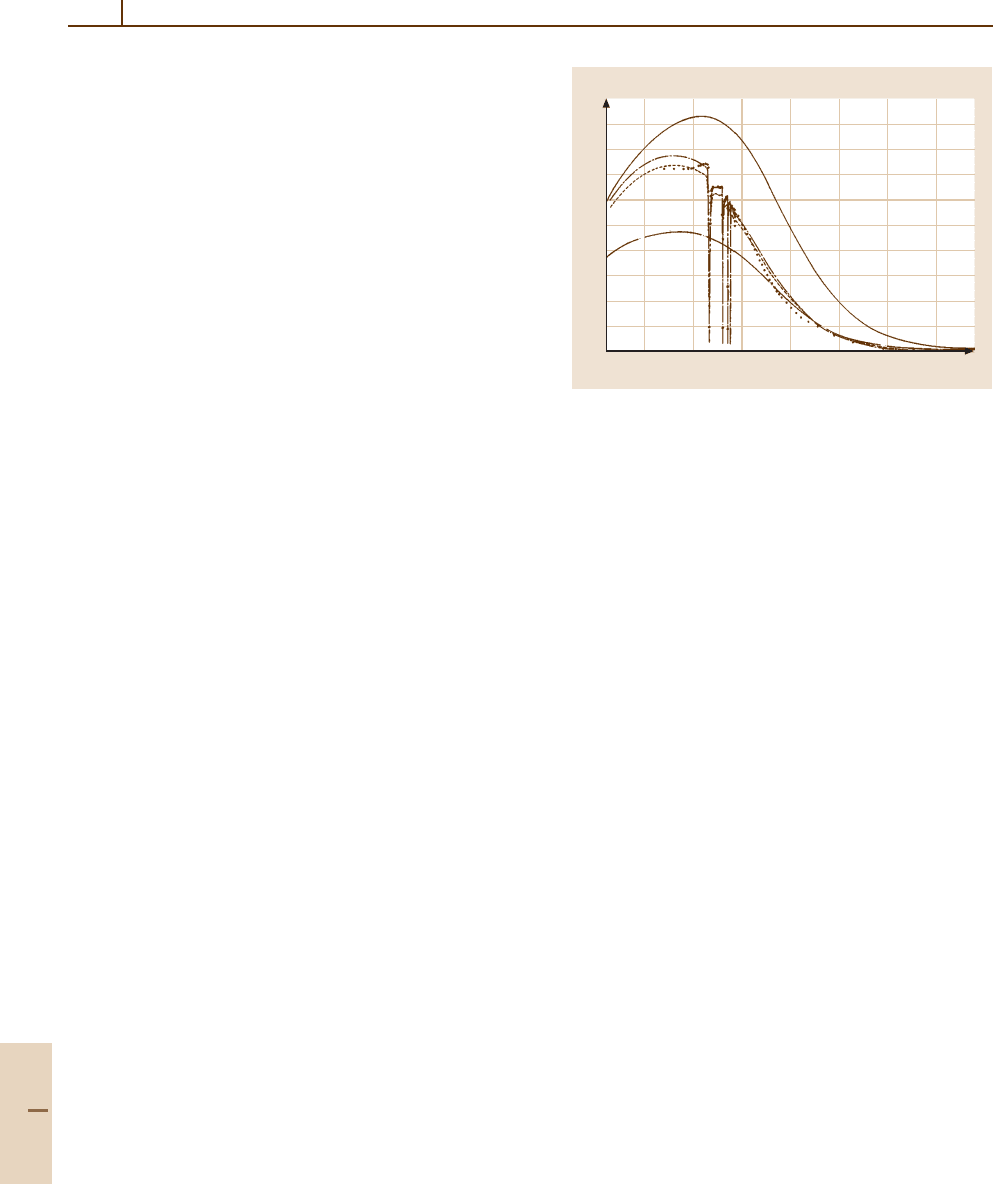Drake G.W.F. (editor) Handbook of Atomic, Molecular, and Optical Physics
Подождите немного. Документ загружается.


379
Photoionizatio
24. Photoionization of Atoms
This chapter outlines the theory of atomic
photoionization, and the dynamics of the
photon–atom collision process. Those kinds of
electron correlation that are most important
in photoionization are emphasized, although
many qualitative features can be understood
within a central field model. The particle–hole
type of electron correlations are discussed,
as they are by far the most important for
describing the single photoionization of atoms
near ionization thresholds. Detailed reviews of
atomic photoionization are presented in [24.1]
and [24.2]. Current activities and interests are
well-described in two recent books [24.3, 4].
Other related topics covered in this volume are
experimental studies of photon interactions at
both low and high energies in Chapts. 61 and
62, photodetachment in Chapt. 60,theoretical
descriptions of electron correlations in Chapt. 23,
autoionization in Chapt. 25, and multiphoton
processes in Chapt. 74.
24.1 General Considerations ........................ 379
24.1.1 The Interaction Hamiltonian....... 379
24.1.2 Alternative Forms
for the Transition Matrix Element 380
24.1.3 Selection Rules
for Electric Dipole Transitions...... 381
24.1.4 Boundary Conditions
on the Final State Wave Function 381
24.1.5 Photoionization Cross Sections.... 382
24.2 An Independent Electron Model ............ 382
24.2.1 Central Potential Model.............. 382
24.2.2 High Energy Behavior ................ 383
24.2.3 Near Threshold Behavior ............ 383
24.3 Particle–Hole Interaction Effects ........... 384
24.3.1 Intrachannel Interactions........... 384
24.3.2 Virtual Double Excitations .......... 384
24.3.3 Interchannel Interactions........... 385
24.3.4 Photoionization of Ar................. 385
24.4 Theoretical Methods
for Photoionization ............................. 386
24.4.1 Calculational Methods ............... 386
24.4.2 Other Interaction Effects............. 387
24.5 Recent Developments........................... 387
24.6 Future Directions ................................. 388
References .................................................. 388
24.1 General Considerations
24.1.1 The Interaction Hamiltonian
Consider an N-electron atom with nuclear charge Z.In
the nonrelativistic approximation, it is described by the
Hamiltonian
H =
N
i=1
p
i
2
2m
−
Ze
2
r
i
+
N
i> j=1
e
2
|r
i
− r
j
|
.
(24.1)
The one-electron terms in brackets describe the kinetic
and potential energy of each electron in the Coulomb
field of the nucleus; the second set of terms describe the
repulsive electrostatic potential energy between elec-
tron pairs. The interaction of this atom with external
electromagnetic radiation is described by the additional
terms obtained upon replacing p
i
by p
i
+ (|e|/c)A(r
i
, t),
where A(r
i
, t) is the vector potential for the radiation.
The interaction Hamiltonian is thus
H
int
=
N
i=1
+|e|
2mc
[ p
i
· A(r
i
, t) + A(r
i
, t) · p
i
]
+
e
2
2mc
2
|A(r
i
, t)|
2
.
(24.2)
Under the most common circumstance of single-photon
ionization of an outer-subshell electron, the interaction
Hamiltonian in (24.2) may be simplified considerably.
First, the third term in (24.2) may be dropped, as it intro-
duces two-photon processes (since it is of second order
in A). In any case, it is small compared with single pho-
ton processes since it is of second order in the coupling
constant |e|/c. Second, we choose the Coulomb gauge
Part B 24

380 Part B Atoms
for A, which fixes the divergence of A as ∇·A = 0.
A thus describes a transverse radiation field. Further-
more p and A now commute and hence the first and
second terms in (24.2) may be combined. Third, we
introduce the following form for A:
A(r
i
, t) =
2πc
2
ωV
1
2
ˆ
e
i(k·r
i
−ωt)
. (24.3)
This classical expression for A may be shown [24.5]to
give photoabsorption transition rates that are in agree-
ment with those obtained using the quantum theory of
radiation. Here kand ω are the wave vector and angular
frequency of the incident radiation,
ˆ
is its polarization
unit vector, and V is the spatial volume. Fourth, the elec-
tric dipole (E1) approximation, in which exp[i(k· r
i
)] is
replaced by unity, is usually appropriate. The radii r
i
of the atomic electrons are usually of order 1 Å. Thus
for λ 100 Å, |k· r
i
|1. Now λ 100 Å corresponds
to photon energies
ω 124 eV. For outer atomic sub-
shells, most of the photoabsorption occurs for much
smaller photon energies, thus validating the use of the
E1 approximation. (This approximation cannot be used
uncritically, however. For example, photoionization of
excited atoms (which have large radii), photoionization
of inner subshells (which requires the use of short wave-
length radiation), and calculation of differential cross
sections or other measurable quantities that are sensitive
to the overlap of electric dipole and higher multipole am-
plitudes all require that the validity of the electric dipole
approximation be checked.) Use of all of the above con-
ventionsand approximations allowsthe reduction of H
int
in (24.2) to the simplified form
H
int
=
+|e|
mc
2πc
2
ωV
1
2
N
i=1
ˆ
· p
i
exp(−iωt).
(24.4)
H
int
thus has the form of a harmonically time-dependent
perturbation. According to time-dependent perturbation
theory, the photoionization cross section is proportional
to the absolute square of the matrix element of (24.4)
between the initial and final electronic states described
by the atomic Hamiltonian in (24.1). Atomic units, in
which |e|=m =
= 1, are used in what follows.
24.1.2 Alternative Forms
for the Transition Matrix Element
The matrix element of (24.4) is proportional to the matrix
element of the momentum operator
i
p
i
. Alternative
expressions for this matrix element may be obtained
from the following operator equations involving com-
mutators of the exact atomic Hamiltonian in (24.1):
N
i=1
p
i
=−i
N
i=1
r
i
, H
, (24.5)
N
i=1
p
i
, H
=−i
N
i=1
Zr
i
r
3
i
. (24.6)
Matrix elements of (24.5)and(24.6) between eigen-
states ψ
0
| and |ψ
f
of H having energies E
0
and E
f
respectively give
ψ
0
|
N
i=1
p
i
|ψ
f
=−iωψ
0
|
N
i=1
r
i
|ψ
f
,
(24.7)
ψ
0
|
N
i=1
p
i
|ψ
f
=
−i
ω
ψ
0
|
N
i=1
Zr
i
r
3
i
|ψ
f
,
(24.8)
where ω = E
f
− E
0
.Matrixelementsof
N
i=1
p
i
,
N
i=1
r
i
,and
N
i=1
Zr
i
/r
3
i
are known as the “veloc-
ity,” “length,” and “acceleration” forms of the E1 matrix
element.
Equality of the matrix elements in (24.7)and(24.8)
does not hold when approximate eigenstates of H are
used [24.6]. In such a case, qualitative considerations
may help to determine which form is most reliable. For
example, the length form tends to emphasize the large r
part of the approximate wave functions, the acceleration
form tends to emphasize the small r part of the wave
functions, and the velocity form tends to emphasize
intermediate values of r.
If instead of employing approximate eigenstates of
the exact H, one employs exact eigenstates of an approx-
imate N-electron Hamiltonian, then inequality of the
matrix elements in (24.7)and(24.8)isameasureofthe
nonlocality of the potential in the approximate Hamil-
tonian [24.7,8]. The exchange part of the Hartree–Fock
potential is an example of such a nonlocal potential.
Nonlocal potentials are also implicitly introduced in
configuration interaction calculations employing a finite
number of configurations [24.7, 8]. One may eliminate
the ambiguity of which form of the E1 transition opera-
tor to use by requiring that the Schrödinger equation be
gauge invariant. Only the length form is consistent with
such gauge invariance [24.7,8].
However, equality of the alternative forms of the
transition operator does not necessarily imply high ac-
curacy. For example, they are exactly equal when one
Part B 24.1

Photoionization of Atoms 24.1 General Considerations 381
uses an approximate local potential to describe the
N-electron atom, as in a central potential model, even
though the accuracy is often poor. The length and ve-
locity forms are also exactly equal in the random phase
approximation [24.9], which does generally give accu-
rate cross sections for single photoionization of closed
shell atoms. No general prescription exists, however, for
ensuring that the length and velocity matrix elements are
equal at each level of approximation to the N-electron
Hamiltonian.
24.1.3 Selection Rules
for Electric Dipole Transitions
If one ignores relativistic interactions, then a general
atomic photoionization process may be described in LS-
coupling as follows:
A(L, S, M
L
, M
S
,π
A
) + γ(π
γ
,
γ
, m
γ
)
−→ A
+
(
¯
L
¯
Sπ
A
+
)ε(L
, S
, M
L
, M
S
). (24.9)
Here the atom A is ionized by the photon γ to produce
a photoelectron with kinetic energy ε and orbital angu-
lar momentum . The photoelectron is coupled to the
ion A
+
with total orbital and spin angular momenta L
and S
. In the electric dipole approximation, the photon
may be regarded as having odd parity, i. e., π
γ
=−1,
and unit angular momentum, i. e.,
γ
= 1. This is ob-
vious from (24.7)and(24.8), where the E1 operator is
seen to be a vector operator. The component m
γ
of the
photon in the E1 approximation is ±1 for right or left
circularly polarized light and 0 for linearly polarized
light. (The z axis is taken as
ˆ
k in the case of circularly
polarized light and as
ˆ
in the case of linearly polar-
ized light, where k and
ˆ
are defined in (24.3).) Angular
momentum and parity selection rules for the E1 transi-
tionin(24.9) imply the following relations between the
initial and final state quantum numbers:
L
= L ⊕ 1 =
¯
L ⊕ , (24.10)
M
L
= M
L
+ m
γ
= M
¯
L
+ m
, (24.11)
S
= S =
¯
S⊕
1
2
,
(24.12)
M
S
= M
S
= M
¯
S
+ m
s
, (24.13)
π
A
π
A
+
= (−1)
+1
. (24.14)
Equation (24.14) follows from the parity (−1)
of the
photoelectron. The direct sum symbol ⊕ denotes the
vector addition of Aand Bi.e, A⊕ B = A+ B, A+ B−
1,... ,| A− B|.
In (24.9), the quantum numbers α ≡
¯
L,
¯
S, π
A
+
,
, L
, S
, M
L
, M
S
(plus any other quantum numbers
needed to specify uniquely the state of the ion A
+
)
define a final state channel. All final states that differ
only in the photoelectron energy ε belong to the same
channel. The quantum numbers L
, S
, M
L
, M
S
,and
π
tot
= (−1)
π
A
+
are the only good quantum numbers
for the final states. Thus the Hamiltonian (24.1)mixes
final state channels having the same angular momen-
tum and parity quantum numbers but differing quantum
numbers for the ion and the photoelectron; i. e., differ-
ing
¯
L,
¯
S, π
A
+
,and but the same L
, S
, M
L
, M
S
and
(−1)
π
A
+
.
24.1.4 Boundary Conditions
on the Final State Wave Function
Photoionization calculations obtain final state wave
functions satisfying the asymptotic boundary condition
that the photoelectron is ionized in channel α.This
boundary condition is expressed as
ψ
−
αE
(r
1
s
1
,... ,r
N
s
N
)
−→
r
N
→∞
θ
α
(r
1
s
1
,... ,
ˆ
r
N
s
N
)
1
i(2πk
α
)
1
2
1
r
N
e
i∆
α
−
α
θ
α
(r
1
s
1
,... ,
ˆ
r
N
s
N
)
1
i(2πk
α
)
1
2
1
r
N
e
−i∆
α
S
†
α
α
,
(24.15)
where the phase appropriate for a Coulomb field is
∆
α
≡ k
α
r
N
−
1
2
π
α
+
1
k
α
log 2k
α
r
N
+ σ
α
. (24.16)
The minus superscript on the wave function in (24.15)
indicates an “incoming wave” normalization: i. e.,
asymptotically ψ
−
αE
has outgoing spherical Coulomb
waves only in channel α, while there are incom-
ing spherical Coulomb waves in all channels. S
†
α
α
is the Hermitian conjugate of the S-matrix of scat-
tering theory, θ
α
indicates the coupled wave function
of the ion and the angular and spin parts of the
photoelectron wave function, k
α
is the photoelectron
momentum in channel α and
α
is its orbital angular
momentum, and σ
α
in (24.16) is the Coulomb phase
shift.
While one calculates channel functions ψ
−
αE
,
experimentally one measures photoelectrons which
asymptotically have well-defined linear momenta k
α
and
well-defined spin states m
1
2
, and ions in well-defined
states
¯
α ≡
¯
L
¯
SM
¯
L
M
¯
S
. The wave function appropriate for
this experimental situation is related to the channel func-
tions by uncoupling the ionic and electronic orbital and
Part B 24.1

382 Part B Atoms
spin angular momenta and projecting the photoelectron
angular momentum states
α
, m
α
onto the direction
ˆ
k
α
by means of the spherical harmonic Y
α
m
α
(k
α
).This
relation is [24.1]:
ψ
−
¯
αk
α
(r
1
s
1
,... ,r
N
s
N
)
=
α
m
α
i
α
exp(−iσ
α
)
k
1
2
α
Y
α
m
α
(
ˆ
k
α
)
×
LM
L
SM
S
¯
LM
¯
L
α
m
α
|LM
L
×
¯
SM
¯
S
1
2
m
1
2
|SM
S
ψ
−
αE
(r
1
s
1
,... ,r
N
s
N
),(24.17)
where the coefficients in brackets are Clebsch–Gordon
coefficients. This wave function is normalized to a delta
function in momentum space, i. e.,
ψ
−
¯
αk
α
†
ψ
−
¯
α
k
α
d
3
r = δ
¯
α
¯
α
δ(k
α
− k
α
). (24.18)
The factors i
α
exp(−iσ
α
)k
−
1
2
α
ensure that for large r
N
(24.17) represents a Coulomb wave (with momen-
tum k
α
) times the ionic wave function for the state
¯
α plus
a sum of terms representing incoming spherical waves.
Thus only the ionic term
¯
α has an outgoing wave. One
uses the wave function in (24.17) to calculate the angular
distribution of photoelectrons.
24.1.5 Photoionization Cross Sections
If one writes H
int
in (24.4)asH
int
(t) = H
int
(0)e
−iωt
,
then from first order time-dependent perturbation theory,
the transition rate for transition from an initial state with
energy E
0
and wave function ψ
0
to a final state with
total energy E
f
and wave function ψ
−
¯
αk
α
is
dW
k
α
= 2π|ψ
0
|H
int
(0)|ψ
−
¯
αk
α
|
2
× δ(E
f
− E
0
− ω)k
2
α
dk
α
dΩ(
ˆ
k
α
). (24.19)
The delta function expresses energy conservationand the
last factors on the right are the phase space factors for
the photoelectron. Dividing the transition rate by the in-
cident photon current density c/V, integrating over dk
α
,
and inserting H
int
(0), the differential photoionization
cross section is
dσ
¯
α
dΩ
=
4π
2
c
k
α
ω
ˆ
· ψ
0
|
N
i=1
p
i
|ψ
−
¯
αk
α
2
. (24.20)
Implicit in (24.19)and(24.20) is an average over initial
magnetic quantum numbers M
L
0
M
S
0
and a sum over
final magnetic quantum numbers M
¯
L
M
¯
S
m
1
2
. The length
form of (24.20) is obtained by replacing each p
i
by
ωr
i
(24.7).
Substitution of the final state wave function (24.17)
in (24.20) permits one to carry out the numerous sum-
mations over magnetic quantum numbers and obtain the
form
dσ
¯
α
dΩ
=
σ
¯
α
4π
[1+ βP
2
(cos θ)] (24.21)
for the differential cross section [24.10]. Here σ
¯
α
is the partial cross section for leaving the ion in
the state
¯
α, β is the asymmetry parameter [24.11],
P
2
(cos θ) =
3
2
cos
2
θ −
1
2
,andθ indicates the direction
of the outgoing photoelectron with respect to the polar-
ization vector
ˆ
of the incident light. The form of (24.21)
follows in the electric dipole approximation from gen-
eral symmetry principles, provided that the target atom
is unpolarized [24.12]. The partial cross section is given
in terms of reduced E1 matrix elements involving the
channel functions in (24.15)by
σ
¯
α
=
4π
2
3c
ω[L]
−1
α
L
ψ
0
N
i=1
r
i
[1]
ψ
−
αE
2
.
(24.22)
The β parameter has a much more complicated expres-
sion involving interference between different reduced
dipole amplitudes [24.1]. Thus measurement of β pro-
vides information on the relative phases of the alternative
final state channel wave functions, whereas the partial
cross-section in (24.22) does not. From the requirement
that the differential cross section in (24.21) be positive,
one sees that −1 ≤ β ≤+2.
24.2 An Independent Electron Model
The many-body wave functions ψ
0
and ψ
−
αE
are usually
expressed in terms of a basis of independent electron
wave functions. Key qualitative features of photoion-
ization cross sections can often be interpreted in terms
of the overlaps of initial and final state one electron ra-
dial wave functions [24.1,13]. The simplest independent
electron representation of the atom, the central potential
model, proves useful for this purpose.
Part B 24.2

Photoionization of Atoms 24.2 An Independent Electron Model 383
24.2.1 Central Potential Model
In the central potential (CP) model the exact H in (24.1)
is approximated by a sum of single-particle terms de-
scribing the independent motion of each electron in
a central potential V(r):
H
CP
=
N
i=1
p
i
2
2m
+ V(r
i
)
. (24.23)
The potential V(r) must describe the nuclear attraction
and the electron–electron repulsion as well as possible
and must satisfy the boundary conditions
V(r)
−→
r→0
− Z/r and V(r)
−→
r→∞
− 1/r (24.24)
in the case of a neutral atom. H
CP
is separable in
spherical coordinates and its eigenstates can be writ-
ten as Slater determinants of one-electron orbitals of
the form r
−1
P
n
Y
m
(Ω) for bound orbitals and of the
form r
−1
P
ε
(r)Y
m
(Ω) for continuum orbitals. The one-
electron radial wave functions satisfy
d
2
P
ε
(r)
dr
2
+ 2
ε − V(r) −
( + 1)
2r
2
P
ε
(r) = 0 ,
(24.25)
subject to the boundary condition P
ε
(0) = 0, and sim-
ilarly for the discrete orbitals P
n
(r). Hermann and
Skillman [24.14] have tabulated a widely used central
potential for each element in the periodic table as well
as radial wave functions for each occupied orbital in the
ground state of each element.
24.2.2 High Energy Behavior
The hydrogen atom cross section, which is nonzero at
threshold and decreases monotonically with increasing
photon energy, serves as a model for inner-shell pho-
toionization cross sections in the X-ray photon energy
range. A sharp onset at threshold followed by a mono-
tonic decrease above threshold is precisely the behavior
seen in X-ray photoabsorption measurements. A simple
hydrogenic approximation at high energies may be jus-
tified theoretically as follows: (1) Since a free electron
cannot absorb a photon (because of kinematical consid-
erations), at high photon energies one expects the more
strongly bound inner electrons to be preferentially ion-
ized as compared with the outer electrons. (2) Since the
P
n
(r) for an inner electron is concentrated in a very
small range of r, one expects the integrand of the radial
dipole matrix element to be negligible except for those
values of r where P
n
(r) is greatest. (3) Thus it is only
necessary to approximate the atomic potential locally,
e.g., by means of a screened Coulomb potential
V
n
(r) =−
Z − s
n
r
+ V
n
o
(24.26)
appropriate for the n orbital. Here s
n
is the “inner-
screening” parameter, which accounts for the screening
of the nuclear charge by the other atomic electrons,
and V
o
n
is the “outer-screening” parameter, which ac-
counts for the lowering of the n electrons’ binding
energy due to repulsion between the outer electrons
and the photoelectron as the latter leaves the atom.
The potential in (24.26) predicts hydrogen-like pho-
toionization cross sections for inner-shell electrons
with onsets determined by the outer-screening param-
eters V
o
n
.
Use of more accurate atomic central potentials in
place of the screened hydrogenic potential in (24.26)
generally enables one to obtain photoionization cross
sections below the keV photon energy region to within
10% of the experimental results [24.15]. For >0 sub-
shells and photon energies in the keV region and above,
the independent particle model becomes increasingly in-
adequate owing to coupling with nearby ns-subshells,
which generally have larger partial cross sections at
high photon energies [24.16]. For high, but still non-
relativistic photon energies, i. e., ω mc
2
, the energy
dependence of the cross section for the n subshell
within the independent particle model is [24.17]
σ
n
∼ ω
−−
7
2
. (24.27)
However, when interchannel interactions are taken into
account, the asymptotic energydependence for subshells
having >0 becomes independent of [24.18]:
σ
n
∼ ω
−
9
2
( > 0). (24.28)
This result stems from coupling of the >0 photoion-
ization channels with nearby s-subshell channels.
24.2.3 Near Threshold Behavior
For photons in the vuv energy region, i. e., near the
outer-subshell ionization thresholds, the photoionization
cross sections for subshells with ≥ 1 frequently have
distinctly nonhydrogenic behavior. The cross section, in-
stead of decreasing monotonically as for hydrogen, rises
above threshold to a maximum (the so called delayed
maximum above threshold). Then it decreases to a min-
imum (the Cooper minimum [24.19, 20]) and rises to
Part B 24.2

384 Part B Atoms
a second maximum. Finally the cross section decreases
monotonically at high energies in accordance with hy-
drogenic behavior. Such nonhydrogenic behavior may
be interpreted as due either to an effective potential bar-
rier or to a zero in the radial dipole matrix element. We
examine each of these effects in turn.
The delayed maximum above outer subshell ioniza-
tion thresholds of heavy atoms (i. e., Z
18) is due to
an effective potential barrier seen by = 2and = 3
photoelectrons in the region of the outer edge of the
atom (24.25). This effective potential lowers the prob-
ability of photoelectron escape until the photoelectrons
have enough excess energy to surmount the barrier. Such
behavior is nonhydrogenic. Furthermore, in cases where
an inner subshell with = 2 or 3 is being filled as Z in-
creases (as in the transition metals, the lanthanides and
the actinides) there is a double well potential. This dou-
ble well has profound effects on the 3p-subshell spectra
of the transition metals, the 4d-subshell spectra of the
lanthanides, and the 5d-subshell spectra of the actinides,
as well as on atoms with Z just below those of these
series of elements [24.1,21, 22].
Cross section minima arise due to a change in sign
of the radial dipole transition matrix element in a par-
ticular channel [24.23, 24]. Rules for predicting their
occurrence were developed by Cooper [24.19,20]. Stud-
ies of their occurrence in photoionization from excited
states [24.25], in high Z atoms [24.26], and in relativis-
tic approximation [24.27] have been carried out. Only
recently has a proof been given [24.28] that such min-
ima do not occur in atomic hydrogen spectra. For other
elements, there are further rules on when and how many
minima may occur [24.29–31].
Often within such minima, one can observe effects
of weak interactions that are otherwise obscured. Rela-
tivistic and weak correlation effects on the asymmetry
parameter β for s-subshells is a notable example [24.32].
Wang et al. [24.33] have also emphasized that near
such minima in the E1 amplitudes, one cannot ignore
the effects of quadrupole and higher corrections to the
differential cross section. Central potential model cal-
culations [24.33] show that quadrupole corrections can
be as large as 10% of the E1 cross section at such cross
section minima, even for low photon energies.
24.3 Particle–Hole Interaction Effects
The experimental photoionization cross sections for the
outer subshells of the noble gases (The noble gases
have played a prominent role in the development of
the theory of photoionization for two reasons. These
were among the first elements studied by experimental-
ists with synchrotron radiation beginning in the 1960’s.
Also, their closed-shell, spherically symmetric ground
states simplified the theoretical analysis of their cross
sections.) near the ionization thresholds can be under-
stood in terms of interactions between the photoelectron,
the residual ion, and the photon field which are called,
in many-body theory language, “particle–hole” inter-
actions (see Chapt. 47). These may be described as
interactions in which two electrons either excite or de-
excite each other out of or into their initial subshell
locations in the unexcited atom. To analyze the effects
of these interactions on the cross section, it is conve-
nient to classify them into three categories: intrachannel,
virtual double excitation, and interchannel. These alter-
native kinds of particle–hole interactions are illustrated
in Fig. 24.1 using both many-body perturbation theory
(MBPT) diagrams and more “physical” scattering pic-
tures. We discuss each of these types of interaction in
turn.
24.3.1 Intrachannel Interactions
The MBPT diagram for this interaction is shown on the
left in Fig. 24.1a; on the right a slightly more picto-
rial description of this interaction is shown. The wiggly
line indicates a photon, which is absorbed by the atom
in such a way that an electron is excited out of the
n subshell. During the escape of this excited elec-
tron, it collides or interacts with another electron from
the same subshell in such a way that the second elec-
tron absorbs all the energy imparted to the atom by
the photon; the first electron is de-excited back to its
original location in the n subshell. For closed-shell
atoms, the photoionization process leads to a
1
P
1
final
state in which the intrachannel interaction is strongly
repulsive. This interaction tends to broaden cross sec-
tion maxima and push them to higher photon energies
as compared with the results of central potential model
calculations.
Intrachannel interaction effects are taken into ac-
count automatically when the correct Hartree-Fock (HF)
basis set is employed in which the photoelectron sees
a net Coulomb field due to the residual ion and is cou-
pled to the ion to form the appropriate total orbital L and
Part B 24.3

Photoionization of Atoms 24.3 Particle–Hole Interaction Effects 385
a)
b)
c)
nl εl⬘
nl
ε⬘l⬘
nl
nl
e
–
e
–
nl
εl⬘
nl
ε⬘l⬘
nl
nl
e
–
e
–
n
1
l
1
ε⬘⬘ l⬘⬘
n
0
l
0
ε⬘l⬘
e
–
e
–
n
1
l
1
n
0
l
0
Fig. 24.1a–c MBPT diagrams (left) and scattering pic-
tures (right) for three kinds of particle–hole interaction:
(a) intrachannel scattering following photoabsorption;
(b) photoabsorption by a virtual doubly-excited state; (c) in-
terchannel scattering following photoabsorption
spin S angular momenta. Any other basis set requires
explicit treatment of intrachannel interactions.
24.3.2 Virtual Double Excitations
The MBPT diagram for this type of interaction is
shownontheleftinFig.24.1b. Topologically, this di-
agram is the same as that on the left in Fig. 24.1a.
In fact, the radial parts of the two matrix elements
are identical; only the angular factors differ. A more
pictorial description of this interaction is shown on
the right of Fig. 24.1b. The ground state of the atom
before photoabsorption is shown to have two elec-
trons virtually excited out of the n subshell. In
absorbing the photon, one of these electrons is de-
excited to its original location in the n subshell,
while the other electron in ionized. These virtual dou-
ble excitations imply a more diffuse atom than in
central-potential or HF models, with the effect that
the overly repulsive intrachannel interactions are weak-
ened, leading to cross sections for noble gas atoms
that are in very good agreement with experiment
with the exception that resonance features are not
predicted.
24.3.3 Interchannel Interactions
The interchannel interaction shown in Fig. 24.1cisim-
portant, particularly for s subshells. This interaction has
the same form as the intrachannel interaction shown in
Fig. 24.1a, except now when an electron is photoexcited
out of the n
0
0
subshell, it collides or interacts with an
electron in a different subshell – the n
1
1
subshell. This
interaction causes the second electron to be ionized, and
the first electron to fall back into its original location in
the n
0
0
subshell.
Interchannel interaction effects are usually very con-
spicuous features of photoionization cross sections.
When the interacting channels have partial photoion-
ization cross sections which differ greatly in magnitude,
one finds that the calculated cross section for the weaker
channel is completely dominated by its interaction with
the stronger channel. At the same time, it is often a safe
approximation to ignore the effect of weak channels
on stronger channels. In addition, when the interacting
channels have differing binding energies, their inter-
channel interactions lead to resonance structure in the
channel with lower binding energy (arising from its cou-
pling to the Rydberg series in the channel with higher
binding energy).
At high photon energies, s-subshell partial cross
sections dominate over >0 subshell partial cross sec-
tions [(24.27), (24.28)]. Hence interchannel interactions
of >0 subshells with nearby s-subshells change in-
dependent particle model predictions significantly. In
particular, as noted in Sect. 24.3.2, such interactions can
drastically change the magnitudes of the >0 partial
cross sections [24.16] as well as their asymptotic energy
behavior [24.18].
24.3.4 Photoionization of Ar
An example of both the qualitative features exhibited by
photoionization cross sections in the vuv energy region
and of the ability of theory to calculate photoionization
cross reactions is provided by photoionization of the
n = 3 subshell of argon, i. e.,
Ar3s
2
3p
6
+ γ → Ar
+
3s
2
3p
5
+ e
−
→ Ar
+
3s3p
6
+ e
−
. (24.29)
Figure 24.2 shows the MBPT calculation of Kelly
and Simons [24.34], which includes both intrachannel
Part B 24.3

386 Part B Atoms
and interchannel interactions as well as the effect of vir-
tual double excitations. The cross section is in excellent
agreement with experiment [24.35, 36], even to the ex-
tent of describing the resonance behavior due to discrete
members of the 3s → εp channel.
Figure 24.2 illustrates most of the features of pho-
toionization cross sections described so far. First, the
cross section rises to a delayed maximum just above
the threshold because of the potential barrier seen by
photoelectrons from the 3p subshell having = 2. For
photon energies in the range of 45–50 eV, the calcu-
lated cross section goes through a minimum because of
a change in sign of the 3p → εd radial dipole amplitude.
The HFL and HFV calculations include the strongly
repulsive intrachannel interactions in the
1
Pfinal-state
channels and calculate the transition amplitude using
the length (L) and velocity (V) form respectively for the
electric dipole transition operator (24.7). With respect
to the results of central potential model calculations, the
HFL and HFV results have lower and broader maxima
at higher energies. They also disagree with each other
by a factor of two! Inclusion of virtual double excita-
tions results in length and velocity results that agree to
within 10% with each other and with experiment, ex-
cept that the resonance structures are not reproduced.
Finally, taking into account the interchannel interac-
tions, one obtains the length and velocity form results
shown in Fig. 24.2 by dash-dot and dashed curves re-
50
45
40
35
30
25
20
15
10
5
0
16 20 25 30 35 40 45 50 54
Photon energy (eV)
σ (10
–18
cm
2
)
HFL
HFV
Fig. 24.2 Photoionization cross section for the 3p and 3s
subshells of Ar. HFL and HFV indicate the length and ve-
locity results obtained using HF orbitals calculated in a
1
P
1
potential. Dot-dash and dashed lines represent the length
and velocityresults of the MBPT calculation of Kellyand Si-
mons [24.34]. Only the four lowest 3s → np resonances are
shown; the series converges to the 3s threshold at 29.24 eV.
Experimental results are those of Samson [24.35] above
37 eV and of Madden et al. [24.36] below 37 eV (After
[24.34])
spectively. Agreement with experiment is excellent and
the observed resonances are well-reproduced.
24.4 Theoretical Methods for Photoionization
24.4.1 Calculational Methods
Most of the ab initio methods for the calcula-
tion of photoionization cross sections (e.g., the
MBPT method [24.37], the close-coupling (CC)
method [24.38], the R-matrix method [24.39, 40], the
random phase approximation (RPA) method [24.9], the
relativistic RPA method [24.41], the transition matrix
method [24.42,43], the multiconfiguration Hartree-Fock
(MCHF) method [24.44–46], etc.) have successfully cal-
culated outer p-subshell photoionization cross sections
of the noble gases by treating in their alternative ways
the key interactions described above, i. e., the particle–
hole interactions. In general, these methods all treat
both intrachannel and interchannel interactions to in-
finite order and differ only in their treatment of ground
state correlations. (The exception is MBPT, which often
treats interchannel interactions between weak and strong
channels only to first or second order.) These methods
therefore stand in contrast to central potential model
calculations, which do not treat any of the particle–hole
interactions, and single-channel term-dependent HF cal-
culations, which treat only the intrachannel interactions.
The key point is that selection of the interactions that
are included in a particular calculation is more impor-
tant than the method by which such interactions are
handled.
Treatment of photoionization of atoms other than
the noble gases presents additional challenges for the-
ory. For example, elements such as the alkaline earths,
which have s
2
outer subshells, require careful treatment
of electron pair excitations in both initial and final states.
Open shell atoms have many more ionization thresholds
than do the noble gases. Treatment of the resultant rich
resonance structures typically relies heavily on quantum
defect theory [24.46] (see Chapt. 32). All the methods
Part B 24.4

Photoionization of Atoms 24.5 Recent Developments 387
listed above can be used to treat elements other than the
noble gases, but a method which has come to promi-
nence because of the excellent results it obtains for both
alkaline earth and open-shell atoms is the eigenchannel
R-matrix method [24.47].
24.4.2 Other Interaction Effects
A number of interactions, not of the particle–hole type,
lead to conspicuous effects in localized energy regions.
When treating photoionization in such energy regions,
one must be careful to choose a theoretical method which
is appropriate. Among the interactions which may be
important are the following:
Relativistic and Spin-Dependent Interactions
The fact that j = −
1
2
electrons are contracted more
than j = +
1
2
electrons at small distances has an enor-
mous effect on the location of cross section minima
in heavy elements [24.15, 48]. It may explain the large
observed differences in the profiles of a resonance de-
caying to final states that differonly in their fine structure
quantum numbers [24.49].
Inner-Shell Vacancy Rearrangement
Inner-shell vacancies often result in significant pro-
duction of satellite structures in photoelectron spectra.
Calculations for inner subshell partial photoionization
cross sections are often substantially larger than results
of photoelectron measurements [24.50–52]. This differ-
ence is attributed to such satellite production, which is
often not treated in theoretical calculations.
Polarization and Relaxation Effects
Negative ion photodetachment cross sections often
exhibit strong effects of core polarization near thresh-
old. These effects can be treated semi-empirically,
resulting in excellent agreement between theory and
experiment [24.53]. Even for inner shell photoion-
ization cross sections of heavy elements, ab initio
theories do not reproduce measurements near thresh-
old without the inclusion of polarization and relaxation
effects [24.54,55].
An Example
The calculation of the energy dependence of the asym-
metry parameter β for the 5s subshell of xenon requires
the theoretical treatment of all of the above effects. In
the absence of relativistic interactions, β for Xe 5s would
have the energy-independent value of two. Deviations of
β from two are therefore an indication of the presence of
these relativistic interactions. The greatest deviation of
β from two occurs in the localized energy region where
the partial photoionization cross section for the 5s sub-
shell has a minimum. In this region, however, relativistic
calculations show larger deviations from two than are
observed experimentally. Inner shell rearrangement and
relaxation effects play an important role [24.56, 57]
and must be included to achieve good agreement with
experiment.
24.5 Recent Developments
One of the most intensively studied areas in atomic
photoionization in recent years has been the double
photoionization of the helium atom. Extensive sets of
experimental measurements for the two electron angular
distributions (i. e., the triply differential cross sections)
have provided stringent tests for various theoretical
models and their treatments of electron correlations.
A number of excellent reviews of this field have been
published recently [24.58–60].
Another intensively studied area has been the
analysis and measurement of non-dipole effects in pho-
toionization, which were first observed in the X-ray
region [24.61] but have been found to be significant even
in the vuv photon energy region [24.62,63]. In general,
these effects stem from interference between electric
quadrupole and the (usual) electric dipole transition am-
plitudes in differentialcross sections (for a recent review,
see [24.64]). Besides asymmetries in the photoelectron
angular distributions, non-dipole effects lead also to new
features for spin-resolved measurements [24.65,66], and
for the case of polarized atoms [24.67]. Recently, non-
dipole effects have been predicted to be significant also
in double photoionization of helium at relatively low
photon energies [24.68].
Finally, both experimental and theoretical studies of
ionic species have flourished over the past decade. In
particular, photodetachment of negative ions near ex-
cited atomic thresholds provides an opportunity to study
correlated, three-body Coulomb states unencumbered
by Rydberg series. Only with the advent of power-
ful computer workstations have theorists been able to
carry out numerical calculations for such high, doubly
excited states with spectroscopic accuracy. Following
experiments for photodetachment of H
−
with excita-
Part B 24.5

388 Part B Atoms
tions of atomic levels in H(n > 2), theorists developed
propensity rules for identifying and characterizing the
dominant photodetachment channels [24.69–71]. More
recently, experimental and theoretical interest shifted
to the negative alkali ions (e.g., Li
−
and Na
−
), which
for low photon energies have outer electron detach-
ment spectra grossly resembling that of H
−
.However,
the negative alkali spectra contain clear signatures of
propensity-rule-forbidden states that become increas-
ingly prominent as the atomic number increases (owing
to the nonhydrogenic inner electron cores). A brief re-
view of low energy negative alkali photodetachment
is given in [24.72]. Among the more general features
brought to light by these studies is the mirroring of
resonance profiles in alternative partial cross sections,
which appears to be a very general phenomenon com-
mon to photodetachment and photoionization processes
involving highly excited residual atoms or ions [24.73].
Recently, high energy (K-shell) photodetachment of
thenegativeionsLi
−
and He
−
(resulting in two elec-
tron ionization) has been studied both experimentally
and theoretically [24.74, 75]. These studies represent
the first results for inner shell photodetachment. There
is general agreement between theory and experiment
well above the K edge, but the theoretical cross sec-
tions at the K edge are significantly higher than the
experimental measurements. The latter discrepancy is
now understood as arising from recapture of the low-
energy detached electron following Auger decay of
the inner-shell vacancy, which when taken into ac-
count theoretically has been shown to provide results
that agree with experiment [24.76, 77]. Also, the first
experimental data together with theoretical analyses
were recently presented for photoionization of ground
and metastable positive ions (O
+
and Sc
++
) [24.78,
79]. With the advent of data for photoionization of
positive ions it now becomes possible (using the prin-
ciple of detailed balance) to make connections to
data for electron–ion photo-recombination cross sec-
tions [24.79].
24.6 Future Directions
The construction of high brightness synchrotron light
sources and the increasing use of lasers are providing
the means to study atomic photoionization processes at
an unparalleled level of detail. The synchrotrons gen-
erally produce photons in the soft X-ray and X-ray
regions. Thus, inner shell vacancy production and decay,
satellite production, and multiple ionization phenom-
ena are all being increasingly studied. Laser sources
are allowing production of atoms in tailored initial
states. Studies of ions, both negativeand positive, in
well-specified states are also increasingly being car-
ried out. Thus, photoionization of excited atoms and
ions and, in particular, complete measurements of par-
ticular photoionization processes, are now possible.
Recent collections of short review papers provide ref-
erences to these topics [24.3, 4]. In addition, two recent
reviews of experimental results for noble gas atom
photoionization [24.80] and for metal atom photoion-
ization [24.81] also provide valuable information on
the current state of the correspondingtheoretical results.
References
24.1 A. F. Starace: Handbuch der Physik, Vol. XXXI, ed.
by W. Mehlhorn (Springer, Berlin, Heidelberg 1982)
pp. 1–121
24.2 M. Ya. Amusia: Atomic Photoeffect (Plenum, New
York 1990)
24.3 T. N. Chang (Ed.): Many-Body Theory of Atomic
Structure and Photoionization (World Scientific,
Singapore 1993)
24.4 U. Becker, D. A. Shirley: VUV and Soft X-Ray Pho-
toionization Studies (Plenum, New York 1994)
24.5 J. J. Sakurai: Advanced Quantum Mechanics
(Addison-Wesley, Reading 1967) p. 39
24.6 S. Chandrasekhar: Astrophys. J. 102, 223 (1945)
24.7 A. F. Starace: Phys. Rev. A 3, 1242 (1971)
24.8 A. F. Starace: Phys. Rev. A 8, 1141 (1973)
24.9 M. Ya. Amusia, N. A. Cherepkov: Case Studies in At.
Phys. 5, 47 (1975)
24.10 J. M. Blatt, L. C. Biedenharn: Rev. Mod. Phys. 24,
258 (1952)
24.11 See Sect. 7 of [24.1]
24.12 C. N. Yang: Phys. Rev. 74,764(1948)
24.13 See, e.g., (9.6)–(9.15) of for expressions for the
reduced matrix elements in (24.22) in which all
angular integrations have been carried out and
the results are expressed in terms of one-electron
radial dipole matrix elements
Part B 24
